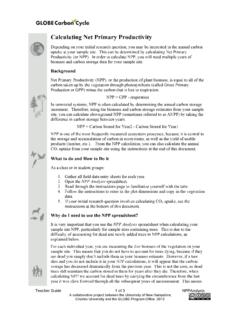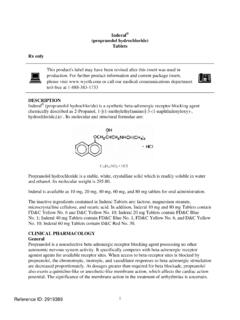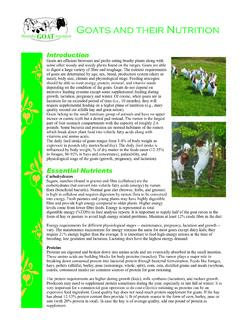Transcription of A INTRODUCTION TO THE GLOBAL CARBON C
1 AN INTRODUCTION TO THE. GLOBAL CARBON CYCLE. CARBON : the building block of life. You may have heard this phrase, but have you fully considered what it really means? All living things are made of elements, the most abundant of which are, oxygen, CARBON , hydrogen, nitrogen, calcium , and phosphorous. Of these, CARBON is the best at joining with other elements to form compounds necessary for life, such as sugars, starches, fats, and proteins. Together, all these forms of CARBON account for approximately half of the total dry mass of living things. CARBON is also present in the Earth's atmosphere, soils, oceans, and crust. When viewing the Earth as a system, these components can be referred to as CARBON pools (sometimes also called stocks or reservoirs) because they act as storage houses for large amounts of CARBON .
2 Any movement of CARBON between these reservoirs is called a flux. In any integrated system, fluxes connect reservoirs together to create cycles and feedbacks. An example of such a cycle is seen in Figure 1 where, CARBON in the atmosphere is used in photosynthesis to create new plant material. On a GLOBAL basis, this processes transfers large amounts of CARBON from one pool (the atmosphere) to another (plants). Over time, these plants die and decay, are harvested by humans, or are burned either for energy or in wildfires. All of these processes are fluxes that can cycle CARBON among various pools within ecosystems and eventually releases it back to the atmosphere. Viewing the Earth as a whole, individual cycles like this are linked to others involving oceans, Atmospheric CARBON Dioxide rocks, etc.
3 On a range of spatial and temporal scales to form an integrated Uptake by photosynthesis GLOBAL CARBON cycle (Figure 2). Return to in the presence atmosphere by of water and On the shortest time scales, of respiration, sunlight decay, fire and seconds to minutes, plants take harvesting Transfer to CARBON out of the atmosphere soils through photosynthesis and release it back into the atmosphere via respiration. On longer time scales, CARBON from dead plant material can CARBON stored in plants and soils be incorporated into soils, where it Figure 1. A sub-cycle within the GLOBAL CARBON cycle. might reside for years, decades or CARBON continuously moves between the atmosphere, centuries before being broken down plants and soils through photosynthesis, plant respiration, harvesting, fire and decomposition.
4 By soil microbes and released back to the atmosphere. On still longer time scales, organic matter1 that became buried in deep sediments (and protected from decay) was slowly transformed into deposits of coal, oil and natural gas, the fossil fuels we use today. When we burn these substances, CARBON that has been stored for millions of years is released once again to the atmosphere in the form of CARBON dioxide (CO2). The CARBON cycle has a large effect on the function and well being of our planet. Globally, the CARBON cycle plays a key role in regulating the Earth's climate by controlling the concentration of CARBON dioxide in the atmosphere. CARBON dioxide (CO2) is important because it contributes to the greenhouse effect, in which heat generated from sunlight at the Earth's surface is trapped by certain gasses and prevented from escaping through the atmosphere.
5 The greenhouse effect itself is a perfectly natural phenomenon and, without it, the Earth would be a much colder place. But as is often the case, too much of a good thing can have negative consequences, and an unnatural buildup of greenhouse gasses can lead to a planet that gets unnaturally hot. In recent years CO2 has received much attention because its concentration in the atmosphere has risen to approximately 30% above natural background levels and will continue to rise into the near future. Scientists have shown that this increase is a result of human activities that have occurred over the last 150 years, including the burning of fossil fuels and deforestation. Because CO2 is a greenhouse gas, this increase is believed to be causing a rise in GLOBAL temperatures.
6 This is the primary cause of climate change and is the main reason for increasing interest in the CARBON cycle. The Earth's CARBON reservoirs naturally act as both sources, adding CARBON to the atmosphere, and sinks, removing CARBON from the atmosphere. If all sources are equal to all sinks, the CARBON cycle can be said to be in equilibrium (or in balance) and there is no change in the size of the pools over time. Maintaining a steady amount of CO2 in the atmosphere helps maintain stable average temperatures at the GLOBAL scale. However, because fossil fuel combustion and deforestation have increased CO2 inputs to the atmosphere without matching increases in the natural sinks that draw CO2 out of the atmosphere (oceans, forests, etc.)
7 , these activities have caused the size of the atmospheric CARBON pool to increase. This is what has been responsible for the present buildup of CO2 and is believed to cause the observed trend of increasing GLOBAL temperatures. How far will CO2 levels rise in the future? The answer depends both on how much CO2 humans continue to release and on the future amount of CARBON uptake and storage by the Earth's natural sinks and reservoirs. In short, it depends on the CARBON cycle. 1. We often refer to CARBON occurring in organic versus inorganic forms. This is a simple way of grouping different forms of CARBON into biologically derived compounds (complex substances produced only by the growth of living organisms) and mineral compounds that can be formed in the absence of biological activity (but can sometimes be formed with the assistance of living things, as in the case of sea shells).
8 Organic compounds includes such things as sugars, fats, proteins and starches and are contained in both living organisms and the material that remains after their death and partial decomposition (including the organic matter in soils as well as the deposits of coal and oils we refer to as fossil fuels). Note that complete decomposition of organic matter results in a return to mineral forms, often as CO2. Mineral forms of CARBON include carbonates contained in rock and seawater as well as CO2 itself. Figure 2. A simplified diagram of the GLOBAL CARBON cycle. Pool sizes, shown in blue, are given in petagrams (Pg) of CARBON . Fluxes, shown in red, are in Pg per year. ( ). POOLS, FLUXES AND A WORD ABOUT UNITS.
9 In order to understand how CARBON is cycled and how atmospheric CO2 will change in the future, scientists must carefully study the places in which CARBON is stored (pools), how long it resides there, and processes that transfer it from one pool to another (fluxes). Collectively, all of the major pools and fluxes of CARBON on Earth comprise what we refer to as the GLOBAL CARBON cycle. As you might imagine, the actual GLOBAL CARBON cycle is immensely complex. It includes every plant, animal and microbe, every photosynthesizing leaf and fallen tree, every ocean, lake, pond and puddle, every soil, sediment and carbonate rock, every breath of fresh air, volcanic eruption and bubble rising to the surface of a swamp, among much, much else.
10 Because we can't deal with that level of complexity, scientists often describe the CARBON cycle by lumping similar objects or environments into simpler groups (forest, grassland, atmosphere, ocean) and focusing only on the processes that are most important at the GLOBAL scale (Figure 2). As you might imagine, part of the trick is understanding just what those processes are. The following section is a brief overview of some of the important pools and fluxes in the GLOBAL CARBON cycle (and note that, in our discussion, we will use the terms pool, stock and reservoir interchangeably). But first, it's worth taking a moment to consider the numbers and units scientists often deal with. Because the quantities of CARBON in the Earth's major CARBON pools can be quite large, it is inconvenient to use familiar units such as pounds or kilograms.







